BeoVision MX 5000 NTSC
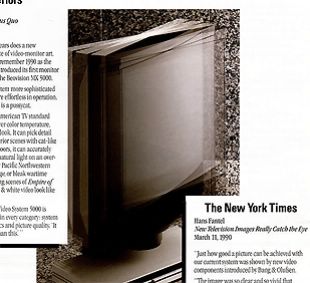
Bang & Olufsen’s first television in the North American market was a variant of the European MX range with important changes to accomodate the different electrical and broadcast systems there.

Bang & Olufsen’s first television in the North American market was a variant of the European MX range with important changes to accomodate the different electrical and broadcast systems there.
Bang & Olufsen’s second television in the North American market was a minor upgrade of the previous MX 5000 NTSC. The major difference was a different CRT tube and a software upgrade to allow bidirectional Infrared communication with the BeoLink 7000 and BeoLink 5000 remote controls.
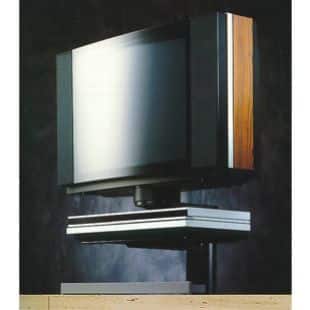
Beovision L 5500 / 4500 – Alternative theatre
A classic Bang & Olufsen TV has always been a good investment. However, if you didn’t need the advanced features that Beovision LX had to offer, the alternative TV was the ‘L’ range. It offered same design, same engineering, same quality, but different pricing and different colours.
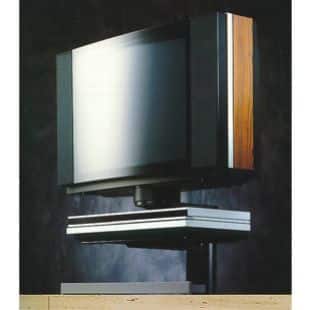
Beovision L 5500 / 4500 – Alternative theatre
A classic Bang & Olufsen TV has always been a good investment. However, if you didn’t need the advanced features that Beovision LX had to offer, the alternative TV was the ‘L’ range. It offered same design, same engineering, same quality, but different pricing and different colours.
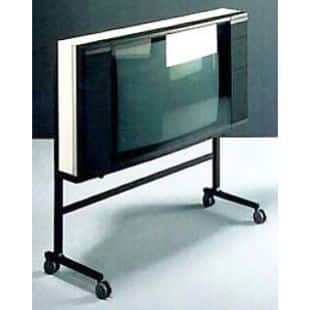
With its 63cm screen, Beovision LX2500 was the smallest member of the LX family in 1987. But no sacrifices were made in sound and picture excellence, nor was Beovision LX2500 ever caught out by new technical developments. No Master Control Link or additional speakers were required when installing a Beovision LX say, in the bedroom. The set came fully-equipped with a Master Control Link and all sound from the central music system could be fed through the TV speakers
Installing a Beovision LX2500 in a study placed communication and information at your fingertips. Using a Beolink 1000 remote-control Terminal you could remote control and utilise all the features of the central system, including Teletext TV and video. And adding a home computer, video games and printer to the Beovision LX2500 used advanced electronics in a thoroughly practical way.
Beovisions LX2800 and LX2500 were identical in every detail except for the size of the picture screen.
Two television sets that were available but without Teletext, hi-fi sound or extra connection facilities were the Beovision L2800 and L2500. Other than these extra features, L2800 and L2500 were identical to the Beovisions LX2800 and LX2500.
Beovision Beovisions LX2800 and LX2500
Designed by David Lewis, the televisions were released in 1986. At the time, the LX range was special as it was the first type of television to include a contrast-screen and automatic picture control called VisionClear. It was controlled by a ‘V Terminal’, the forerunner of Beolink 1000. It was also the first TV range with an Audio/Aux Link and hi-fi speakers.
Beovision Beovisions LX2800 and LX2500 features:
Flat-square picture tube. Part of the VisionClear system which provides picture of studio quality
In-line self-converging picture tube, also part of the VisionClear system. Reduces the chance of inadvertent mixing of picture colours and ensures perfect pictures throughout the life of the TV.
Automatic Cut-off – yet another part of the VisionClear system. An electronic circuit which adjusts the colour balance 50 times every second. A patented Bang & Olufsen innovation which ensures that you get lifelike colours – automatic and operates all the time.
Contrast screen – the most visually outstanding part of the VisionClear system. A Bang & Olufsen screen which reduces the effect of incident light. This ensures clear colours and optimum contrast conditions even in bright light.
Automatic contrast control – the picture’s contrast level is automatically adjusted to match the light levels in the room.
Remote-controlled channel tuning – included all relevant TV channels. You could use the buttons on the Beolink 1000 terminal to order the frequency of a specific TV channel and let the electronics take care of search, tuning and fine tuning. With the exception of the automation, it was the same search system that you used when you wished to find a new station on your radio.
AFC – A circuit that ensures perfect fine tuning and operated completely automatically.
Fine tuning – a manual feature which gave you access to sharp, stable pictures when reception conditions were poor or if the frequency of a signal deviated from standard settings e.g. in the case of cable TV, home computers etc. Fine tuning adjustments could of course, be stored in the memory.
2 x 15 watts sinus power output – the newly developed LX2800 and LX2500 speakers were based on the bass reflex system which gave the sound image extra depth and detail in hi-fi quality.
When there was a simulcast you could also send sound from the radio out through the speakers of Beovisions LX2800 and LX2500.
Stereo width adjustment ‘increased’ the distance between the speakers and gave a wider, richer sound image.
Enhanced mono broadcasts – the special stereo width circuit also improved the sound quality of mono broadcasts.
Extra hi-fi speakers – you could use the speakers on Beovision LX2800 or LX2500 as an extra pair of speakers for your hi-fi system as part of a Beolink® system.
Built-in Teletext decoder – the (then) new, ‘flickerless’ computer-controlled Teletext decoder (CCT) meant that you had the latest news right at hand as well as a whole host of information channels.
Computer-controlled Teletext (CCT) – had two memories so you could immediately ‘leaf’ up to two pages ahead on Teletext or back to the previous page. One touch and no waiting. Another memory store remembered up to four pages of Teletext information and provided immediate access to the TV listings or the complete Pools results, for example. This short-term memory was erased when the TV was returned to stand-by.
Three Teletext alphabets – if you received Teletext from a country with an alphabet that differed from your own, the Teletext alphabet switched over automatically.
Video recordings of Teletext subtitles – for the first time ever, it was possible to record the Teletext subtitles along with the TV programme itself. This was a big help for the hard-of-hearing
Completely stable and ‘flickerless’ picture from home computers and TV games.
Built-in clock – When Teletext was broadcast, you could bring the correct time on-screen, either for a few seconds or for as long as you liked.
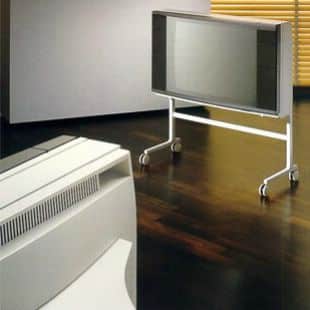
Advanced TV technology at its most elegant
Beovision 2802 was the latest version of the classic Bang & Olufsen TV. Fully remote controlled, it was created specially for those who require all the features of today’s TV – and who also seek a timeless design that would blend perfectly into their living environment. Slim and elegant, Beovision LX2802 came in either traditional natural woods or a contemporary white finish.
To the finest detail
B&O is renowned for its attention to detail and craftsmanship. You won’t find any fussy buttons on B&O’s sets – because, with full remote control, they simply aren’t necessary. Absolutely nothing looks out of place or superfluous with a Bang & Olufsen TV. The materials are always selected with the utmost care. The closest attention is always paid even to the design of the back of the TV. The company believes that appearances matter a great deal, because you’ve got to live with a TV day in, day out. On or off, it should be easy on the eye.
The perfect picture – from any angle
You don’t have to sit bang in front to get a good view of Bang & Olufsen TV sets. The 66cm flat-square picture tube of these Beovisions gave a clear, undistorted picture even when viewed from the side. Combine that with the specially developed VisionClear system, and you’ve got eye-opening picture quality. The colour balance and contrast are regulated automatically, 50 times every second. There’s even a contrast screen to make sure that your picture’s always in harmony with the light levels in the room. Razor-sharp quality – and it’s built to last.
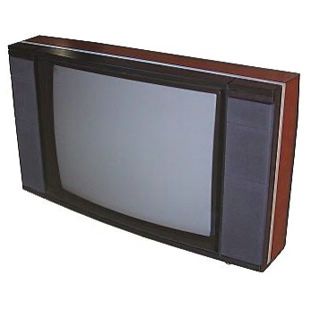
Beovision LX2800, LX2500
Beovision LX2800 and Beocord VHS 91.2 made up the ultimate video system. A harmonious fusion of aesthetic beauty, technical excellence and operational simplicity.
The combination of a 66cm flat-square TV and a stereo video recorder with up to four hours’ video and eight hours’ hi-fi quality music on a single tape hands you remote-controlled access to all forms of TV.
With its 63cm screen, Beovision LX2500 was the smallest member of the LX family in 1987. But no sacrifices were made in sound and picture excellence, nor was Beovision LX2500 ever caught out by new technical developments. No Master Control Link or additional speakers were required when installing a Beovision LX say, in the bedroom. The set came fully-equipped with a Master Control Link and all sound from the central music system could be fed through the TV speakers.
Installing a Beovision LX2500 in a study placed communication and information at your fingertips. Using a Beolink 1000 remote-control Terminal you could remote control and utilise all the features of the central system, including Teletext TV and video. And adding a home computer, video games and printer to the Beovision LX2500 used advanced electronics in a thoroughly practical way.
Beovisions LX2800 and LX2500 were identical in every detail except for the size of the picture screen.
Two television sets that were available but without Teletext, hi-fi sound or extra connection facilities were the Beovision L2800 and L2500. Other than these extra features, L2800 and L2500 were identical to the LX2800 and LX2500.
Designed by David Lewis, the televisions were released in 1986. At the time, the LX range was special as it was the first type of television to include a contrast-screen and automatic picture control called VisionClear. It was controlled by a ‘V Terminal’, the forerunner of Beolink 1000. It was also the first TV range with an Audio/Aux Link and hi-fi speakers.
Beovision LX2800 and LX2500 features:
Flat-square picture tube. Part of the VisionClear system which provides picture of studio quality.
In-line self-converging picture tube, also part of the VisionClear system. Reduces the chance of inadvertent mixing of picture colours and ensures perfect pictures throughout the life of the TV.
Automatic Cut-off – yet another part of the VisionClear system. An electronic circuit which adjusts the colour balance 50 times every second. A patented Bang & Olufsen innovation which ensures that you get lifelike colours – automatic and operates all the time.
Contrast screen – the most visually outstanding part of the VisionClear system. A Bang & Olufsen screen which reduces the effect of incident light. This ensures clear colours and optimum contrast conditions even in bright light.
Automatic contrast control – the picture’s contrast level is automatically adjusted to match the light levels in the room.
Remote-controlled channel tuning – included all relevant TV channels. You could use the buttons on the Beolink 1000 terminal to order the frequency of a specific TV channel and let the electronics take care of search, tuning and fine tuning. With the exception of the automation, it was the same search system that you used when you wished to find a new station on your radio.
AFC – A circuit that ensures perfect fine tuning and operated completely automatically.
Fine tuning – a manual feature which gave you access to sharp, stable pictures when reception conditions were poor or if the frequency of a signal deviated from standard settings e.g. in the case of cable TV, home computers etc. Fine tuning adjustments could of course, be stored in the memory.
2 x 15 watts sinus power output – the newly developed LX2800 and LX2500 speakers were based on the bass reflex system which gave the sound image extra depth and detail in hi-fi quality.
When there was a simulcast you could also send sound from the radio out through the speakers of Beovisions LX2800 and LX2500.
Stereo width adjustment ‘increased’ the distance between the speakers and gave a wider, richer sound image.
Enhanced mono broadcasts – the special stereo width circuit also improved the sound quality of mono broadcasts.
Extra hi-fi speakers – you could use the speakers on Beovision LX2800 or LX2500 as an extra pair of speakers for your hi-fi system as part of a Beolink® system.
Built-in Teletext decoder – the (then) new, ‘flickerless’ computer-controlled Teletext decoder (CCT) meant that you had the latest news right at hand as well as a whole host of information channels.
Computer-controlled Teletext (CCT) – had two memories so you could immediately ‘leaf’ up to two pages ahead on Teletext or back to the previous page. One touch and no waiting. Another memory store remembered up to four pages of Teletext information and provided immediate access to the TV listings or the complete Pools results, for example. This short-term memory was erased when the TV was returned to stand-by.
Three Teletext alphabets – if you received Teletext from a country with an alphabet that differed from your own, the Teletext alphabet switched over automatically.
Video recordings of Teletext subtitles – for the first time ever, it was possible to record the Teletext subtitles along with the TV programme itself. This was a big help for the hard-of-hearing.
Completely stable and ‘flickerless’ picture from home computers and TV games.
Built-in clock – When Teletext was broadcast, you could bring the correct time on-screen, either for a few seconds or for as long as you liked.
A wealth of connection facilities
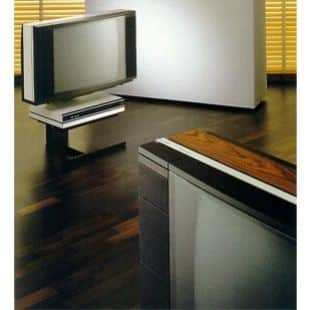
Advanced TV technology at its most elegant
Beovision 2802 was the latest version of the classic Bang & Olufsen TV. Fully remote controlled, it was created specially for those who require all the features of today’s TV – and who also seek a timeless design that would blend perfectly into their living environment. Slim and elegant, Beovision LX2802 came in either traditional natural woods or a contemporary white finish.
To the finest detail
B&O is renowned for its attention to detail and craftsmanship. You won’t find any fussy buttons on B&O’s sets – because, with full remote control, they simply aren’t necessary. Absolutely nothing looks out of place or superfluous with a Bang & Olufsen TV. The materials are always selected with the utmost care. The closest attention is always paid even to the design of the back of the TV. The company believes that appearances matter a great deal, because you’ve got to live with a TV day in, day out. On or off, it should be easy on the eye.
The perfect picture – from any angle
You don’t have to sit bang in front to get a good view of Bang & Olufsen TV sets. The 66cm flat-square picture tube of these Beovisions gave a clear, undistorted picture even when viewed from the side. Combine that with the specially developed VisionClear system, and you’ve got eye-opening picture quality. The colour balance and contrast are regulated automatically, 50 times every second. There’s even a contrast screen to make sure that your picture’s always in harmony with the light levels in the room. Razor-sharp quality – and it’s built to last.
And the sound to match
One of the things that make Bang & Olufsen TVs so special is the sound – because it’s just as breathtakingly good as the picture. The L and LX TVs have a bass reflex loudspeaker system – which, in words of one syllable, means great sound. You’ll be amazed at the difference it makes, even listening to the news! Of course, you’ll also appreciate Bang & Olufsen sound quality when you listen to music from your sound system through the TV. (Perfectly possible – all Bang & Olufsen’s latest audio, TV and video systems can talk to each other). Close your eyes and it sounds like you’ve just acquired a splendid pair of new hi-fi speakers for your music centre. Which is exactly what you HAVE done.
A view to the future
Your LX 2802 TV was also ready for satellite broadcasts when they became available. It’ll be able to receive broadcasts either through communal aerials and a hybrid network, or through your own parabolic ‘dish’ antenna. Just add the BeoSat LX module when the future arrives.
No-wait Teletext
The live information bank of Teletext is a tremendous benefit, whether you want an instant weather update, flight times or racing results. Now we’ve added even more of a bonus, with the computer-controlled Teletext module. This allows you to flip through the Teletext pages without having to wait. You can also call up four different pages instantly on the screen (in the order you want) by pressing the Teletext button. So you can hop easily from one topic to another, with quicker access to the facts you need.
The right connections
When you buy a Bang & Olufsen video recorder to partner your TV, you’ll be able to operate both with one remote control – the Beolink 1000. Needless to say, our video recorders are as intelligently designed as our TVs: Beocord VX5000 and VHS 82.2 even have a visual display to make operation and programming absolute child’s play. But your connection options don’t stop there. Your TV can team up with your music system. It can even form part of your Bang & Olufsen ’round-the-house’ TV, video and music system. All under the command of the ingenious Beolink 1000 remote control. You can also connect headphones, your personal computer, video games and a loop amplifier for the hard of hearing.
Take four
You could choose one of four models: the 63cm L2502 and LX 2502, and the 66cm L2802 and LX 2802. In all the most important technical respects, these TVs shared the same advanced features.
Fine finishes
The Beovision LX series was available in rosewood, teak, white and White Line (B&O’s modern colour and styling treatment).
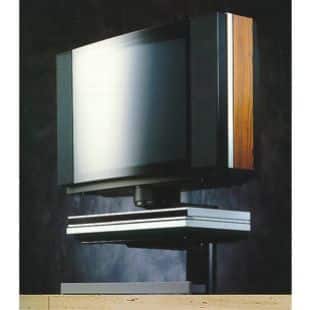
Beovision LX 5500 / 4500 and Beovision L 5500 / 4500
Beovision LX was the result of several generations of development. Superb technology offering a wealth of functions. And the elegant design was sheer pleasure to look at. Without doubt, Beovision LX was a thoroughbred, according to Bang & Olufsen’s 1990 catalogue. And the Beocord VX5000 video cassette recorder a worthy stable mate.
Bang & Olufsen continually seeks new ways not only to streamline operation and function but to simplify exteriors. The powerful speakers of Beovision LX had a totally smooth facade when they were originally introduced in 1990. The contrast screen in front of the picture tube stretches from the very top to the very bottom of the cabinet. And the lacquer was as polished as a grand piano’s.
The result was unity; no knobs or displays interrupted the flow.
You could keep an eye on more than one programme at a time by letting a miniature picture run in one corner of the screen. Or you could show 4, 9 or 16 ‘clips’ from programmes on air at that very moment. Beovision LX 5500 also gave fast, direct access to to four Teletext pages you used the most. And there was room for a satellite receiver to be installed as well as using the TV set for the connection of extra speakers, loop amplifier for the hard of hearing and TV game consoles.
By mounting the whole TV set on a motorised base, you could sit in your armchair and turn the TV up to 35 degrees to each side with just one press of your Beolink 1000 remote control terminal. By programming it into the set, the TV then turned automatically towards your favourite viewing position every time the set switches on. And, naturally, the TV returned to centre stage each time you switched it off.
A stage designer can creative positive associations of purity by using predominantly white or light grey in stage sets and costumes. White and grey symbolize a simple style of living and, as the audience, we associate this virtue in our mind’s eye with the person who decorates with, or dresses in, these light colours. In interior design white and grey give a modern impression with everything blending together, perfectly executed down to the tiniest detail. For those who prefer an all-white look,. Bang & Olufsen in 1990 dressed its Beovision LX range completely in white; even the back.
You could put Beovision LX White Line in the middle of a large room if you so desired. It looked discreet and elegant and spoke its own, well-modulated design language. If a pleasant light grey was more to your taste, the Beovision LX range was available in a light grey finish too. All the other technicalities internally were identical to the other LX family members.

Beovision LX 5000 and LX6000 were the classic Bang & Olufsen televisions, with the loudspeakers on either side of the screen. They were equipped with 66cm and 63cm Black Line picture tubes and VisionClear which makes the picture sharper and the colours clearer. Automatic adjustment of the contrast and light strength continuously kept the picture optimal under different light conditions in the room.
The powerful loudspeakers were based on a two-way bass reflex loudspeaker system that delivered the high sound quality of more and more TV programmes and video tapes. Both TVs were equipped with A2 and NICAM stereo systems.
A BeoSat LM satellite receiver could be built in, allowing access to 99 TV or radio programmes via a parabolic aerial. A D2MAC decoder could also be built in. Bang & Olufsen made it possible for you to pre-program the recording of video programmes from the satellite. The satellite receiver and video recorder were operated by the same Beolink® remote control that operated the TV.
The same remote control also did the work if the Beovision LX6000 and LX5000 were coupled to a Bang & Olufsen music system. Other connection options were headphones, decoders, TV games and camcorder.